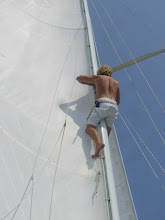Permanent ice in the Arctic Ocean likely did not appear until about two and a half million years ago. At this time, the Arctic as we know it today began to develop. This new Arctic, while less harsh than the Antarctic, still boasts mean winter temperatures that can reach thirty degrees below zero centigrade. Over thousands of years, snow and ice have shaped the region. Much of the Arctic ice has been formed by repeated snowfalls, one on top of the other. Over time, the snow compacts into ice. The ice formed during this settling process has small air bubbles, which provide some of the buoyancy that can cause icebergs to protrude partially above the surface. In Antarctica, icebergs floating just at or below the surface are both a hazard and impediment to mariners. In the Arctic, however, icebergs are less prevalent – although they are increasing in frequency as large-scale coastal ice sheets have recently been shedding mass at record rates.
In 2010, the very ice and snow that have long defined the Arctic region is melting in a self-reinforcing feedback loop. Whereas ice and snow reflect the sun's rays, as more ice and snow melts a greater amount of dark sea surface and dark-soiled permafrost are exposed to the sun's rays. These dark surfaces absorb more heat than the ice, causing the warming and melting process to continue in an accelerating fashion. Indeed, open ocean water absorbs about 80% more radiation than sea ice does; this phenomenon is called ice-albedo or ice-reflective feedback. Ice-albedo is partially responsible for the remarkable decline in sea ice that led to the opening of the Northwest Passage to cargo vessels in 2007 and the opening of both the Northwest Passage and Northern Sea Route in 2008 for the first time in history.
For shippers, an ice-free Arctic passage is more hospitable than the Southern Ocean latitudes of the Roaring Forties and Screaming Fifties just north of Antarctica. First off, storms in the Arctic region are typically more benign than in the Antarctic. In addition, waves in the Arctic run into obstacles such as icebergs and islands which reduce both their size and intensity as they travel around the globe. Meanwhile, waves in the Antarctic travel without impediment around the globe, a phenomenon that can leads to some of the largest wave conditions on the globe. The prevailing east-west Arctic wind is likewise diminished by the presence of surface obstacles on its way around the globe in a fashion that the Antarctic wind is not. Researchers do predict increased Arctic storm intensity but while Arctic wave and wind conditions can be brutal, they do not compare to the intensity of conditions proximate to the South Pole in the Southern Ocean.
Currents are important for Arctic maritime operations that rely on accurate forecasts of ice movement and formation within the region. Regional surface currents, driven by prevailing winds, have an east-west flow. However, the most important of the Arctic currents is the warm water North Atlantic Drift, which flows north into the region from the western mid-Atlantic. The Arctic Ocean deep water current, which flows south beneath the North Atlantic Drift, helps to offset the incoming flow of the North Atlantic Drift by returning the warm surface water of the North Atlantic Drift as cold deep water. The Arctic Ocean current is formed when the North Atlantic Drift heads north, cools and because of its high salt content settles beneath the surface waters of the Arctic. As the North Atlantic Drift makes its way further north, its waters become still colder and settle deeper, eventually reversing direction and forming the southerly Arctic Ocean deep water current.
This Atlantic conveyor system is vital to the climates of northern Europe. The current is known to have stopped before and a weakening of its current is considered to be the cause of Europe's 'Little Ice Age' during the late 17th and early 18th centuries. As the melting Greenland ice sheets dilute the salty surface waters of the Arctic, the current could be stopped or slowed once more. This would significantly impact the climate of northern Europe until the ice sheet finished melting and the salinity in the water was somewhat restored.
On the North Pacific side of the Arctic and north of Russia air masses have a greater effect than sea currents on temperature since there is no such salinity mismatch between converging surface waters and as such no significantly strong currents. The only other major current affecting the Arctic is the Labrador Current, which carries cold water and air to Canada and Greenland via the Davis Strait to the west of Greenland.
Visibility in the Arctic is poor despite the often panoramic landscape and seascape. There is year-round cloud cover approximately 80% of the time in the Atlantic Arctic; in the Eurasian, central and Canadian Arctic this figure diminishes to 60% during winter. Because water vapor freezes into suspended ice crystals at temperatures below thirty degrees centigrade, the Arctic experiences dense fog during the winter months that can cause extended whiteout conditions. In heavily settled areas where higher emissions levels increase the incidence of fog related to water vapor, such fog is a well-documented phenomenon. In addition, glare from the sun off of highly reflective snow and ice surfaces can cause painful temporary blindness if one’s eyes are not properly protected. Such impediments to visibility necessitate sophisticated equipment for safe navigation and detection of obstacles aboard ships operating in the Arctic. Such equipment should be mandated by any Arctic shipping regulations in order to reduce the risk of collision with another vessel or a navigational hazard. This equipment would also help to reduce poor user navigational judgments based primarily on a visual assessment of a vessel's surroundings rather than Geographical Positioning System, radar, sonar and other instrument-based information systems.
22 January 2010
Subscribe to:
Post Comments (Atom)




No comments:
Post a Comment